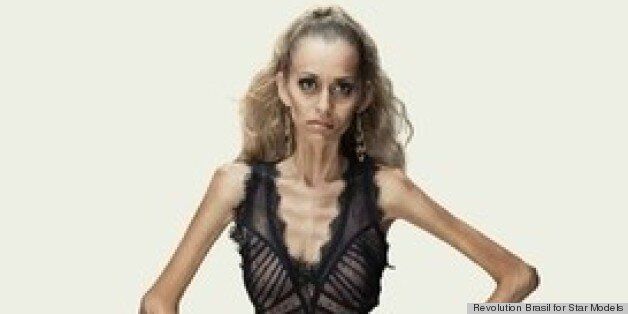
I've just read the July 2013 edition of British Vogue and I'm seriously underwhelmed. Not because I don't enjoy the pages of glossy advertisements (as much a part of the magazine's content as the actual copy itself), the pictures of lavish clothes and jewellery that I can't afford, or the interview with the ever-thrilling Helena Bonham Carter. It's the models. I'm bored of them.
There's been a nagging sense that all is not well in fashion, vocalized particularly in the last ten years and crystalized by instances such as the 2006 deaths of Brazilian model Ana Carolina Reston and Uruguayan model Luisa Ramos, and Alexandra Shuman's tight-lipped refusal to comment on the eating habits of models. I've always been aware that the models are a bit too thin and that makes me sad, but I think I'm ready to throw my hat in the ring and state that I've had quite enough of this homogenous clothes-hanger culture. The models might have different hair and eye colours and be wearing different couture creations, but they're really tall, bone-bag skinny and essentially, they all look the same. The same angular face stares back at me from every luxury brand advertisement I look at, be it Moss, Delevigne, or someone not quite so well-paid.
They don't look like anyone I know. I'm perfectly aware of the theory that high fashion is an escape, as a beautiful, ethereal, other-worldly playground where one does not have to be grounded in reality, but hanging these clothes on extra-terrestrial models instils more than just dull envy. It creates a situation where women are forced to compare themselves with an unrealistic body ideal. Why are pro-anorexic websites crammed with pictures of catwalk models whose legs look incapable of supporting a rice cracker, never mind a human being? The answer is obvious. Because models look really thin, and thin, ill girls like to hold them up as good examples and as physical goals to strive for.
One of the best things about being alive and a human, on a planet of six billion others, is that we're all different. The variety inherent in our humanity extends to style, taste, appearance and many, many other things. Why should high fashion be exempt from recognising, and celebrating this?
We all need clothes (even if you're a committed nudist because everyone has to pop out to get milk and fags now and then), which suggests that clothes should be made for lots of different heights and weights. Sure, H&M might stock size XL and I can find things that look good on someone as miniature as me (5ft 2in if you were wondering) but the big fashion houses is where the high-end creativity happens. The fact that designers send out sample size 6 for someone of 5ft 9 and above sends out a very clear message: that this is the body type that they favour, the one they want to put their clothes on, the most valuable kind of body to have.
This buck-passing attitude, the 'oh but the top agencies send us these skeletal models' and the 'oh but the designers only make the clothes in tiny sample sizes' circular evasion has to stop. Someone needs to take responsibility and step up to the table on this one. My own eating disorder featured a real obsession with the size of models, their bodies were a kind of sick Holy Grail, and even at five and a half stone I didn't feel thin enough (read: good enough) to belong to the model-girl club. I don't want Vogue to be accompanied by a mental trigger warning but until some real change occurs, my love of high fashion will be tainted by unease and, for want of a better word, boredom.